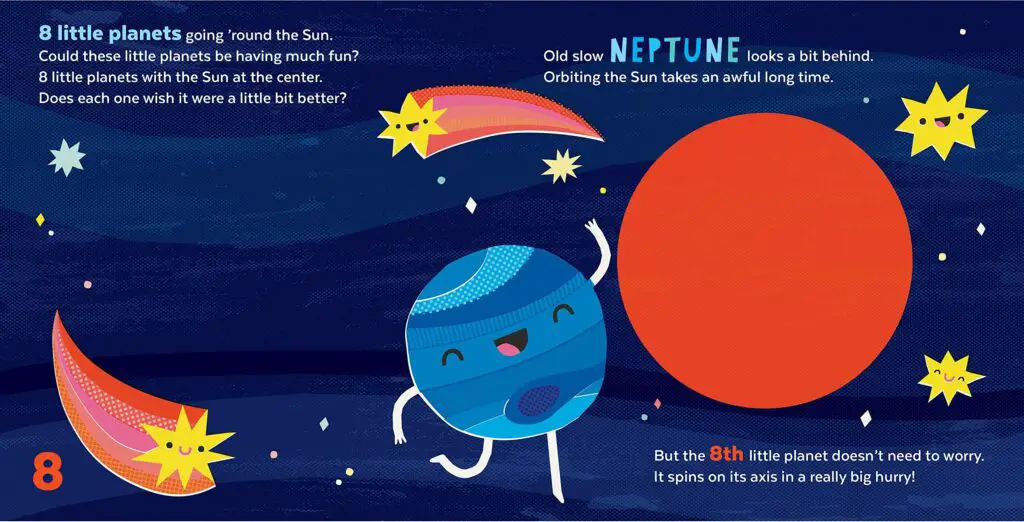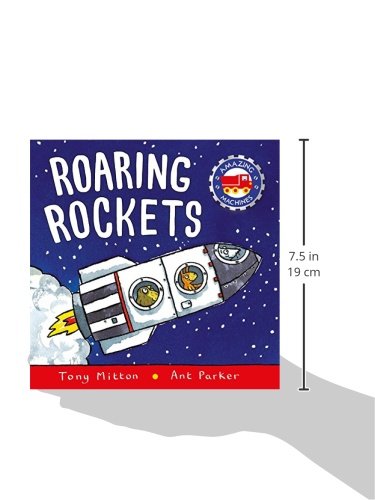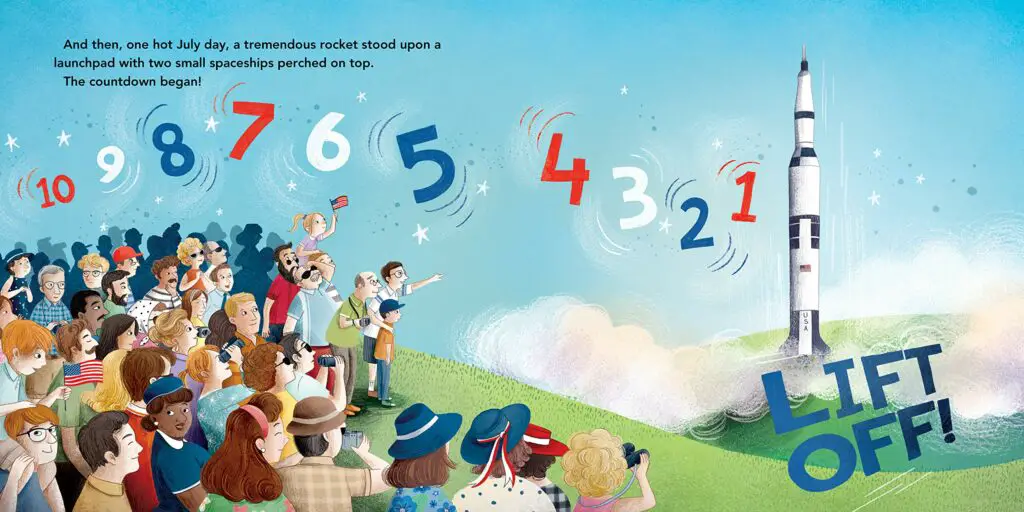Most kids are naturally interested in discovering the world around them. Often, this curiosity extends beyond Earth. With imagination as immense as the galaxies, they love to think about what could be out there and learn about things beyond what their little eyes could see.
One of the best ways to encourage that interest and nurture their innate curiosity is through reading books. Whether you’re here to delight your already-budding astronaut or just looking for some good materials for introducing space to your students, we’ve got you covered.
Great Space Books for Preschoolers
From the story of a young aspiring astronaut to a cheerful, friendly planet, here is our selection of the best space books for preschoolers.



Inspired by the life of Mae Jemison, the first African American woman to reach space, this picture book debut from Roda Ahmed and illustrator Stasia Burrington beautifully instills a positive mindset in kids about dreaming big and working hard to pursue it.
In this story, young Mae dreams of becoming an astronaut and seeing Earth from afar – something her parents are very supportive of. But when she shares her ambitions in school, the class responds with laughter, while her teacher tries to redirect her choice toward something else. Hurt and dismayed, Mae is once again encouraged by her parents– reassuring her she can be anything she wants if she just believes and works hard for it. Eventually, she follows their advice and succeeds in fulfilling her promise of waving to them from space one day.
Sweet and visually appealing, Mae Among the Stars is perfect for space enthusiasts or any young readers who aspire for the stars.

Filled with fascinating facts comprehensively put together by Catherine Hughes, vibrant illustrations by David Aguilar, and captivating photographs, this book is a perfect first step into the world of space exploration!
Although not a one-time read-aloud type of book, it features an exciting and interactive format designed to make little learners want to read a page or two every night. It also neatly explains the concepts of space, starting with what is most familiar to kids, such as the moon and the sun, venturing further into galaxies and black holes. Aside from the usual knowledge about the solar system and the universe, this book touches on NASA spacecrafts as well– detailing each spacecraft’s destination and expected arrival time.
National Geographic: Little Kids First Big Book of Space will be most enjoyed by kids around ages 3-6 or even older space seekers in early elementary.



From the bestselling science author for kids, Chris Ferrie, comes this fact-filled and colorful board book geared towards preschoolers interested the most in learning all about the planets. Through decent rhyming text, this book explores the eight planets starting from the farthest, Neptune, to the closest to the Sun, Mercury.
The book’s pages feature fun die-cut concentric circles in decreasing sizes, with the Sun appearing at their center– making it irresistible to flip through. On top of that are Lizzy Doyle’s bright, cute, and smiling illustrations that young readers sure would love to stare at.
Aside from being an adorable introduction to planets, 8 Little Planets is also a mini-counting book in its own way. It counts from eight down to one rather than up– a concept that’s being taught as early as preschool age.

Next to a mini-counting book discussed above is this engaging twelve-to-one rocket countdown picture book by Michael Dahl, ready to take your little astronauts from their bedroom to space!
Perfect for feeding little astronauts’ or engineers’ curiosity, the book explores everything that takes place before a rocket launch through light text and colorful illustrations by Derrick Alderman and Denise Shea, who in addition, cleverly hide each number on each page for kids to find.
As mentioned, counting backward is one of the important number skills taught to early learners as it sets them for later math concepts such as subtraction and division. On the Launch Pad makes a great gift for every rocket-loving kid starting to know their numbers.

Tish Rabe, with the help of illustrator Aristides Ruiz, makes learning about space beyond fun in this book featuring the beloved characters from everyone’s favorite, Dr. Seuss’ Cat in the Hat!
In this book, Cat in the Hat takes kids on a quick, fun tour through the solar system and back home again in his spaceship. Throughout the ride, The Cat demonstrates its knowledge of each of the planets, the Sun, constellations, and bits about the moon landing in a light, familiar rhythmic manner it is known for.
Following Pluto’s downgrade to a dwarf planet in 2006, the current There’s No Place Like Space edition shares a new way of remembering the order of the planets easily (M,V,E,M,J,S,U,N) that every young space enthusiasts must know.



Another rhyming book on the list that will make kids want to zoom into space is this rocket-themed book from the Amazing Machines series by Tony Mitton and Ant Parker.
Through playful illustrations, the book engages young readers as it follows a charming trio of animal astronauts that soars into space for a lunar lander mission. It shows how a rocket works in a way kids can understand – from the crew getting ready for the launch, the moment it whizzes up, to the time it comes back to Earth. On top of that are the witty couplets that will have kids begging you to read them again.
The Roaring Rockets will be appreciated the most by preschoolers who are not only into space but animals and anything vehicles too.



An educational picture book about the first moon landing framed in a sweet and heartwarming story perfect for a bedtime read-aloud.
Filled with beautiful illustrations by Elisa Paganelli, author Susanna Leonard Hill uniquely narrates in this book the Apollo 11 mission from the perspective of the Queen of the Night Sky herself. It follows the Moon, starting billion of years ago, as she watches life on Earth evolve – lonely and wondering if humans will ever come to visit her. Until finally one day, a spaceship is able to reach her, bringing her heart so much joy.
Moon’s First Friends is a must-have for kids. Aside from the cute fictionalized tale, it also includes bonus content about the real-life events and the people behind the mission.

Margaret NcNamara’s peculiar, celestial retelling of the classic kids’ favorite The Three Little Pigs, accented by bright and detailed illustrations by Mark Fearing, makes a fun and engaging bedtime read-aloud for any young readers interested in aliens and robots.
In the story, the mother of alien siblings Bork, Gork, and Nklxwcyz sends them out into the universe to find their own planets. She warns them, though, to stick around and beware of the Big Bad Robot who “wants to chew them up”. True and soon enough, the evil robot’s pursuit of the siblings across the solar system begins.
The Three Little Aliens makes a great gift for space-loving preschoolers with curious minds and immense imagination.



In his picture book debut, retired astronaut and now politician Mark Kelly delights kids with a heartwarming story of smallness and bravery.
In this story brought to life by C. F. Payne’s stunning illustrations, the astronauts are about to head to space with a few mice aboard the shuttle. Meteor is the smallest mouse of the bunch, but seeing his motivation and hard work, the commander chooses him for one of the six mouse spots. After the liftoff, the astronauts face a disaster when an irreplaceable key gets stuck in a tight spot, but tiny Meteor hurls into action and is able to save the day.
Reinforcing the idea that being small can be useful and that hard work pays off, Mousetronaut is a great read-aloud for every little astronaut-wannabes.



From Stacy McAnulty’s Our Universe series comes this amusing nonfiction that will draw in young readers who are curious about the red planet, Mars. Creatively told from the perspective of Mars himself, the book presents interesting facts in a cheery tone, combined with charming illustrations by Stevie Lewis.
In the book, Magnificent Mars, a “party planet” as he claims, invites Earthlings to come visit and spend time with him as he wishes to be “the first planet with human guests.” To persuade the readers more, he enumerates his unique attractions—ranging from oceans, mountains, and two moons, to volcanoes deeper than Earth’s.
Fun and fact-filled, Mars! Earthlings Welcome makes a perfect treat for kids obsessed with anything solar system.
Conclusion
Preschool is the best age to foster kids’ imagination and curiosity—and reading books is one of the best ways to do it. Moreover, maintaining their fascination with space and astronomy allows them to have an unforced desire to understand increasingly complex science and math concepts.
Hopefully, the space books reviewed here are able to spark your kids’ curiosity even more and inspire them to be future space explorers and scientists!
People Also Ask
As wide-ranging a concept as it is, it’s only natural that there are questions from parents or teachers like you about space and/or about dealing with your space-loving kids. In this section, we answer some of those
The best way to introduce preschoolers to space or astronomy, in general, is to start with basic concepts most familiar to them. For instance, you can initiate a discussion about the sun, moon, and stars as you watch the sky. And as their curiosity grows, venture further into the solar system, galaxies, and beyond, through hands-on activities, play, and reading materials.
To preschoolers, the subject of outer space is pretty abstract. Even kindergarteners will not fully understand it. You can start teaching your kids about all things visible to them such as the sun, moon, and stars. Then introduce them to rockets, planets, and further into space exploration.
Up for more preschool books? You might be interested in these:






